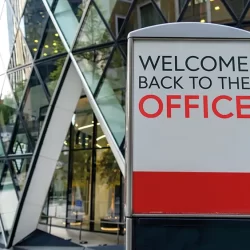How best to embrace the new normal?

A new study aims to help organisations understand and navigate the challenges of the post-pandemic workplace – Amanda Jones of King’s Business School unpacks the findings
The transition into the post-pandemic era presents organisations with a new set of workplace-related challenges. ‘The Work/Place: London returning’ project, led by the Policy Institute and King’s Business School, King’s College London, aims to identify and assist with these challenges by examining the impact of the pandemic on London’s economy, social structure, and working practices which have followed the rise in hybrid working during the government lockdowns. The project has brought together employers and policymakers to identify and explain the changes in London’s working patterns and to explore what the future of work may look like both in London and beyond. As part of this project, we asked senior managers from major London employers to describe how remote working was experienced in their organisations during the pandemic, their lessons learned, and their intentions towards their work location strategy going forward. Our results identified five major challenges which were largely shared amongst London’s top employers:
Challenge 1: Inconsistent perceptions of who remote working benefits and how it should be practised
Contrasting views on who benefits or loses out from remote working and how it should be practised presents a significant challenge to creating shared, accepted justifications for it within organisations. This is important as we identified a perceived power shift where employers now feel compelled to justify office attendance, rather than asking employees to make a case to work remotely. One example is that senior managers feel younger employees lose out most from working remotely due to reduced visibility within the organisation and lower exposure to learning opportunities. These drawbacks are seen by senior managers as a good justification for increased office attendance among younger workers. By contrast, our related survey findings – from a sample of 2,000 London-based employees – demonstrated that younger employees had a positive view of their remote working arrangements, and most would rather quit their jobs than compromise this flexibility. The disparity may result from misalignment in what younger, often more junior, employees and more senior, often older employees view as career success. Evidence suggests that younger generations place greater value on achieving autonomy, flexibility, and wellbeing within their careers whereas older employees tend to measure success more by salary and hierarchical position. While remote working might arguably hamper the latter, there is lots of evidence to suggest it can enhance the former.
On top of this, there are disagreements regarding how many days employees should work in the office and how these days should be organised (e.g., fixed, floating, etc.). Our observation is that overall, what most organisations desire is a steady state. Such an outcome may be achieved through actively listening to employees’ views and preferences and fostering shared expectations by finding common ground on which to base high-level organisational policies for hybrid working.
Challenge 2: Reversing or incorporating changes
Organisations must now decide which pandemic-related changes to reverse or to permanently incorporate. Some organisations have simply gone back to the office, which can be straightforward if employees are able and willing. Others have opted for hybrid working or to save space by going fully remote. But for many, deciding how to use remote working has been a more complex process. For example, after successfully introducing remote working during the lockdowns one senior manager described initially seeing it as an opportunity to plug skill gaps and compete for new talent, but later decided that office working was necessary to restore company culture. New recruits who were knowingly recruited in distant locations argued that expected office attendance was neither practical nor reasonable. These new, remote employees were then harder to integrate. At the same time existing employees, who may have experienced enhanced satisfaction, wellbeing, or work-life balance improvements through working remotely during the pandemic legitimately asked: “Why should I come when they don’t have to?”
Organisations are therefore advised to think very carefully about the “fit” of remote working with corporate culture, implement trial periods for new work arrangements and evaluate their effectiveness before making permanent decisions.
Challenge 3: Role and expectation management
Clarifying and managing the expectations of senior leaders, middle management, and employees regarding office presence is crucial for the successful implementation of hybrid working, no matter how often people attend. The transition to a hybrid model has been particularly challenging for middle managers as many organisations have a broad policy relating to office attendance but delegate decisions on individuals’ working arrangements to line managers. This approach provides flexibility but risks managers being forced into “difficult and messy” conversations that they may not be equipped to deal with. For example, if employees request changes to working practices to help manage a legally protected characteristic.
Employers can provide training to managers on effective leadership and using appropriate processes in a hybrid working environment and set clear guidelines and expectations for office presence and remote work for different roles. They could also ensure expert guidance is available to assist line managers with uncertain or delicate situations.

Challenge 4: Transition management
Managing the transition back to the office requires careful coordination of tasks and working preferences. Employers we spoke to had noticed a reluctance among employees to return to the office, especially where hybrid working had been experienced positively. As some organisations (Bendigo and Adelaide Bank serve as a recent example) have discovered, mandating employees’ office return can lead to a backlash. Consequently, where possible, providing incentives for in-person work – such as free food and drink or even massages and puppies to play with – and developing a mutually recognised, business focused justification for increased office-based presence is advisable.
Setting up open, multi-way communication channels such as surveys, focus groups and dedicated forums can encourage feedback and participation between managers and employees. Subsequently ensuring that everyone is clear on the purpose and value of remote working policies is essential as employees are far more likely to alter their behaviour, even away from their preference, if they feel included in their development and understand their purpose. Regular check-ins with employees are crucial for ongoing evaluation and adjustment which requires both managers and HR professionals to take a hands-on role.
Challenge 5: The office… what to do with the office?
The shift to hybrid working raises the challenge of optimising office space and technology and creating attractive environments to entice employees back while retaining the benefits of both flexibility and maintaining a central city location.
Continuously learning to optimise space is essential for organisations, especially when creating collaborative environments. Office redesign must account for both individual tasks and online collaborations to avoid inadvertently encouraging remote work; if the office is not suited to individual tasks as well as collaboration, it will undoubtedly hamper productivity and employees will be enticed back to the relative privacy of their home.
There was evidence that senior management have embraced hybrid working with a wider strategic purpose. Some have capitalised on a large and loyal, but distributed workforce to acquire smaller offices in more desirable locations (as HSBC recently have). Others described creative strategies such as retaining their space and gifting some to free start-ups that they see as desirable future collaborators as part of their long-term strategic plan. There have also been examples of consolidating offices, resulting in increased collaboration between teams who had previously resided in different locations. On top of this, we learned about an impressive array of technologies and internal office design initiatives aimed at creating space, which is desirable, flexible, and productive. Whichever strategy is used, effective and creative space utilisation remains vital for organisations to justify a prime location, encourage office attendance where desired and remain an attractive employer.
About the Author

Dr Amanda Jones is an Associate Professor in Organisational Behaviour and Human Resource Management at King’s Business School, King’s College London. ‘The Work/Place: London returning’ project can be found via www.kcl.ac.uk














